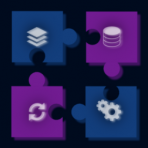- Sky
- Blueberry
- Slate
- Blackcurrant
- Watermelon
- Strawberry
- Orange
- Banana
- Apple
- Emerald
- Chocolate
- Charcoal
-
Content Count
6 -
Joined
-
Last visited
-
Days Won
2
Reputation Activity
-
 TetraSource got a reaction from Parindraa in Bundle - allows to use multiple filesystems as a single one
TetraSource got a reaction from Parindraa in Bundle - allows to use multiple filesystems as a single one
Thanks for the effort @BrisingrAerowing . I've just integrated your changes with minor changes and bugfixes on my part into the repo and updated the pastebin file.
In order to distinguish it from the old version, I also moved Bundle to version v1.1.
-
 TetraSource got a reaction from Fingercomp in Bundle - allows to use multiple filesystems as a single one
TetraSource got a reaction from Fingercomp in Bundle - allows to use multiple filesystems as a single one
I just finished the first version of bundle - a rc application which virtually merges multiple filesystems into a bigger one. You can use it whenever a RAID full of tier 3 HDD isn't enough for your needs. On the picture above, for example, you can see 10 RAIDs with 30 tier 3 HDDs which yield a virtual HDD that can store over 200MB of data. You can also use filesystems of different size and create files bigger than any of the used filesystems since bundle is capable of storing a file on multiple HDDs.
If you encounter any bug, please report it on my github repository. Also check out the wiki page.
How to use it
First of all you can download it from pastebin (id: TmeSNidd) or my github repository and install the file in the directory for rc script (/etc/rc.d/bundle.lua). Before using it you should configure the constants at the top of the script in accordance with their descriptions. Otherwise Bundle might work incorrectly. Then you need to add some filesystems by executing
rc bundle add [address] in the shell. Please replace [address] by the address of the desired filesystem. Doing so wipes the added filesystem. However, Bundle never incorporates filesystems automatically. Next you should allow bundle to run in background by executing
rc bundle enable Just reboot the computer and it should be listed by
df
Note that the label of the first added filesystem and the filesystem provided by Bundle are always equal since that's the way how bundle stores it. You can also view the added filesystems by executing
rc bundle list You can also remove added filesystems by
rc bundle remove [forcefully] Currently, this just removes the last added filesystem, however. If the removal causes the lose of data this fails except you set [forcefully].
Usage notes
Don't install the OS on a Bundle filesystem since Bundle requires some functions of OpenOS. Bundle uses a virtual copy of the file structure. On the one hand this makes "hardware" operations faster, on the other hand it might lead to errors when running out of memory. Bundle works with Lua 5.2 as well as Lua 5.3. Known bugs
Seek operations that set the current position to a value that is bigger than the size of the file cause the file the become bigger than its actual physical size. This is also the case on filesystem components of Open Computers but with bundle it might cause internal errors. That is it for now, have fun using Bundle.
-
 TetraSource got a reaction from Totoro in Bundle - allows to use multiple filesystems as a single one
TetraSource got a reaction from Totoro in Bundle - allows to use multiple filesystems as a single one
I just finished the first version of bundle - a rc application which virtually merges multiple filesystems into a bigger one. You can use it whenever a RAID full of tier 3 HDD isn't enough for your needs. On the picture above, for example, you can see 10 RAIDs with 30 tier 3 HDDs which yield a virtual HDD that can store over 200MB of data. You can also use filesystems of different size and create files bigger than any of the used filesystems since bundle is capable of storing a file on multiple HDDs.
If you encounter any bug, please report it on my github repository. Also check out the wiki page.
How to use it
First of all you can download it from pastebin (id: TmeSNidd) or my github repository and install the file in the directory for rc script (/etc/rc.d/bundle.lua). Before using it you should configure the constants at the top of the script in accordance with their descriptions. Otherwise Bundle might work incorrectly. Then you need to add some filesystems by executing
rc bundle add [address] in the shell. Please replace [address] by the address of the desired filesystem. Doing so wipes the added filesystem. However, Bundle never incorporates filesystems automatically. Next you should allow bundle to run in background by executing
rc bundle enable Just reboot the computer and it should be listed by
df
Note that the label of the first added filesystem and the filesystem provided by Bundle are always equal since that's the way how bundle stores it. You can also view the added filesystems by executing
rc bundle list You can also remove added filesystems by
rc bundle remove [forcefully] Currently, this just removes the last added filesystem, however. If the removal causes the lose of data this fails except you set [forcefully].
Usage notes
Don't install the OS on a Bundle filesystem since Bundle requires some functions of OpenOS. Bundle uses a virtual copy of the file structure. On the one hand this makes "hardware" operations faster, on the other hand it might lead to errors when running out of memory. Bundle works with Lua 5.2 as well as Lua 5.3. Known bugs
Seek operations that set the current position to a value that is bigger than the size of the file cause the file the become bigger than its actual physical size. This is also the case on filesystem components of Open Computers but with bundle it might cause internal errors. That is it for now, have fun using Bundle.





